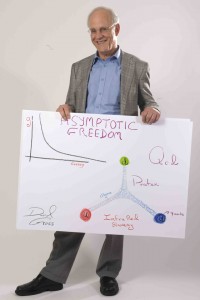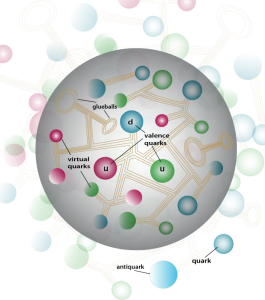
Nobel Laureate David Gross Interview Describes The Ecology Inside Atoms
 “New discoveries tend to be intuitive, just on the borderline of believability. Later, they become obvious.”
“New discoveries tend to be intuitive, just on the borderline of believability. Later, they become obvious.”
“In science, it is essential never to be totally certain.”
“I do not view the present situation as a crisis, but as the kind of acceptable scientific confusion that discovery eventually transcends.”
“We were all looking for the next overthrow, and we were willing to sacrifice existing theories at the drop of a hat.”
The above pull quotes from an interview with Nobel laureate David Gross are perfect reminders for those who would be known as scientists instead of technicians. In a fantastic interview Prof. Gross provides some incredible insights on his view of the ecology and ecosystem inside of atoms. Though I am taking the liberty of translating his language of quantum chromo dynamics into my world of ecology.

Protons would fly apart except for the strong nuclear force, which is carried by gluons (force lines between quarks). When gluons clump together they form a “glueball.” Modern conception of the proton includes more than the three “valence” quarks — a down (d) and two up (u) quarks — which account for only about 2 percent of the proton’s mass. The rest comes from a “sea” of virtual quarks and glueballs. Even outside the bounds of the proton, virtual particles spring into and out of existence within the teeming vacuum described by QCD. (Rendering courtesy of Alex Dzierba, Curtis Meyer and Eric Swanson)
David J. Gross explored the hidden inner world of the atomic nucleus. He helped to reinvent string theory in the 1980s. Today he continues to explore the basic forces of nature, walking in a world of the infinitely small, at the Planck scale (billions of times smaller than a proton), where, string theorists hope, the equations of gravity and quantum mechanics might mesh.
Gross, H. David Politzer and Frank Wilczek were awarded the Nobel for discovering asymptotic freedom, more colloquially known as the strong force that all important force that binds the components of the atomic nucleus into what we perceive as protons and neutrons. Forty years ago, their counterintuitive calculations plugged an important gap in the Standard Model of physics, which describes the 61 known elementary particles. This theoretical work revitalized the nearly moribund quantum field theory and gave birth to QCD (quantum chromodynamics), the theory of the strong interactions.
Sometimes, he says, science is just plain stuck until new data, or a revolutionary idea, breaks the dogma. But he is optimistic: Experience tells him that objects that once could not be directly observed, such as quarks and gluons, can be proven to exist, just how or in what environment, that is the trail that must be found and followed.
He notes in the interview, “When I was at Berkeley, the framework of quantum field theory could calculate the dynamics of electromagnetism. It could roughly describe the motion of the weak nuclear force, radiation. But it hit a brick wall with the strong interaction, the binding force.
Were theorists looking for a more effective theory of elementary particles?
My advisor, Geoffrey Chew, went even further: declaring that there are no elementary particles, but only casually connected interactions that obey probabilistic laws. Thus, in the S-matrix framework, particles created particles, with no particle type being more elemental than any other type. Chew called this non-theory “nuclear democracy” or “the bootstrap.”
For some people, the bootstrap was a revolutionary approach — a new philosophy of physics.”
Since the founding of quantum mechanics in the 1920s, theoretical physics had nurtured an extremely radical tradition. Because relativity and quantum mechanics had revolutionized physics, we were all looking for the next overthrow, and we were willing to sacrifice existing theories at the drop of a hat.
Was revolution a young person’s game?
Not at all. The older physicists were the most radical! The founders of quantum mechanics — Werner Heisenberg, Paul Dirac, Niels Bohr — were all convinced that in order to explain the nuclear force, there had to be another revolution in the foundations of physics. There were all sorts of crazy ideas: Space had to break up at the nuclear scale; quantum mechanics was really nonlinear.
Consistently in this interview Gross speaks to the challenge and the wonderful excitement of exploring in world’s of the unknown. Especially in the key characteristics of the strong nuclear force. It is the glue of everything and yet it is a near total mystery.
When he chaired the 25th Solvay Conference in 2011, he described in his opening remarks, that there is “confusion at the frontiers of physics.” When asked why? He noted, “A scientific frontier is defined as a state of confusion.”
On the question, Is there a crisis in physics? He responds, “I do not view the present situation as a crisis, but as the kind of acceptable scientific confusion that discovery eventually transcends.”
How about public perceptions, does the broad public understand the role of uncertainty in science?
His response, “The public generally equates uncertainty with a wild guess. Whereas, for a scientist, a theory like the Standard Model is incredibly precise and probabilistic.
In science, it is essential never to be totally certain.
And that lesson is hammered into every scientist and reader of history. Scientists measure uncertainty using probability theory and statistics. And we have comfort zones when making predictions, error bars. Living with uncertainty is an essential part of science, and it is easily misunderstood.”
Professor Gross certainly has an amazing clarity of thought on the complexity and wonder inside of atoms. He reminds me of some of the great ecologists I have know, always exploring, always aware that around every new boulder and tree there might be something totally unexpected and amazing to discover.
Read the full interview with David Gross on the web of the Simons Foundation for Basic Science and Mathematics